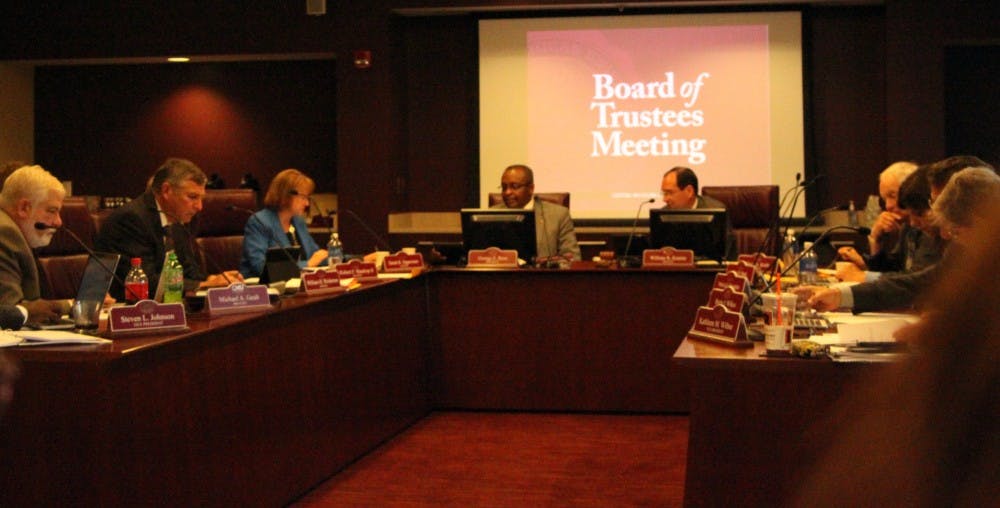University expenses increase $73.4 million in five years
University spending has increased $73.4 million in five years.
In June, the Central Michigan University Board of Trustees unanimously voted to increase the university's operating budget by $21 million. This set the 2015-16 budget at $483 million.
The main sources of revenue are state appropriations and student tuition. State appropriations account for slightly more than $80 million, enough for 62 days of university operation. Today, 57.7 percent of the university's revenue comes from tuition.
Vice President of Finance and Administrative Services Barrie Wilkes said if state appropriations kept up with inflation, CMU would be receiving $132 million from Lansing.
Instead, administrators balance CMU's budget after recieving a minor increase in state funding and an annual tuition increase paid by students.
Wilkes said about 60 percent of CMU's expenditures go to wages and benefits for 2,600 administrators, professors and staff.
"People like to get a raise every year--that's going to increase our expenditures," Wilkes said. "Each year, we try to look at the university and decide where we need to invest to keep it going forward and staying current. Depending on what that decision is, it also would drive an increase in the budget."
This year, the budget increased in several areas: $6.1 million in financial aid, $5.9 million for staff compensation increases, $2.3 million more for the Athletics Department subsidy and an additional $513,000 to Enrollment and Student Services.
Since 2010, the university's allocation to financial aid has increased by $5.4 million. Financial aid consistently shows the highest expenditure in service area costs of the university. Additional funds for the Athletics Department were used to comply with Title IX, adding two new women's sports, lacrosse and golf.
"(Athletics) had a general increase that they needed to cover for operations," Wilkes said. "Things like travel cost more."
The Athletics Department is part of a group called subsidized auxiliary centers. These are areas of the university which aren't self-supporting, Wilkes said.
Throughout the last five years, the highest expenditures of subsidized auxiliaries is the Athletics Department. Though their revenue is about $6.2 million, the department's expenses amount to $27.3 million. Expenses for subsidized areas have increased by about $19 million since 2010.
In order to support them, Wilkes said money is taken from CMU's general fund, which consists primarily of revenue from state appropriations and tuition.
"We also bring in some money out of the endowment, and indirect overhead related to sponsored research, but those amounts are quite small," Wilkes said.
Tuition and state appropriations are also allocated to the academic colleges. Funding is pulled back from the colleges to cover non-academic parts of the university, like finance or the President's Office.
Of every dollar of tuition and state appropriations the colleges receive, a certain amount is allocated to scholarships, libraries, technology, research support functions and other non-revenue generating areas.
Colleges that have students taking more credit hours will receive more from the university's general fund.
"All of the tuition for the academic college that is putting out those classes goes directly to that college," Wilkes said.
State appropriations are allocated to each college based on a three-year average of student credit hours.
"If you look at the student credit hours that different colleges had over the past three years and average them, (funds) are divided up into whatever percent (the college's) student credit hours are," Wilkes said.
The college that consistently receives the most funding based on this principle is College of Humanities and Social and Behavioral Sciences. Funding for this college has increased about $6.9 million over the past five years.
The college which consistently receives the least from the general fund is the College of Communications and Fine Arts. In 2015, the college received $38.7 million, compared to CHSBS at $83.3 million.
While these funds come from students' wallets and Lansing, Wilkes said other assets, like building renovations and new programs involve other sources.
Wilkes said the university looks at where CMU can stop spending, or where it can spend differently on the academic side.
For example, the university has invested more in active learning classrooms throughout the past few years, and larger expenses like the College of Medicine and the Biosciences Building. Wilkes said additional projects are a matter of the academic colleges evolving and staying current--or not. He cited the university matching the College of Business Administration on its renovation to Grawn Hall as an example of departmental innovation.
"There are a lot of conversations going on across the university," Wilkes said. "It's not just the president and the Board of Trustees and senior leadership. It's people in the academic departments, all across campus."




